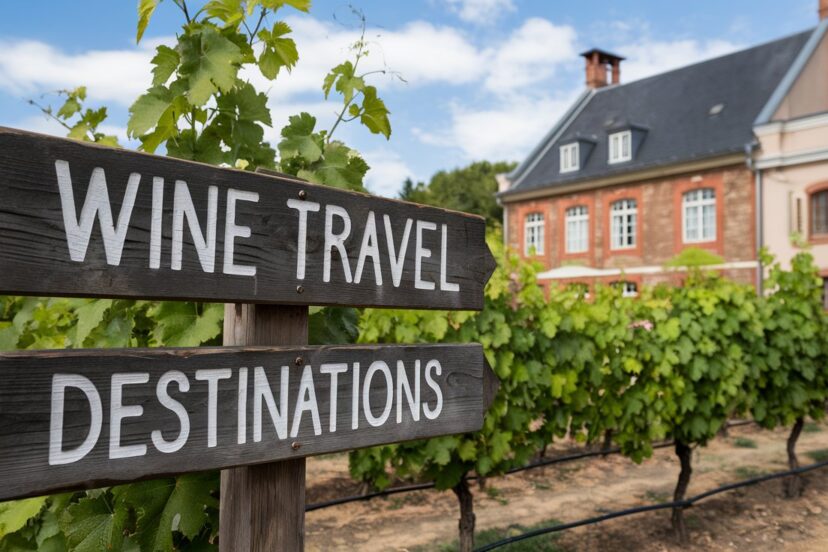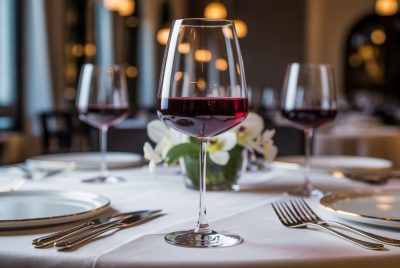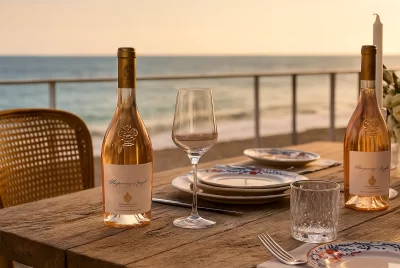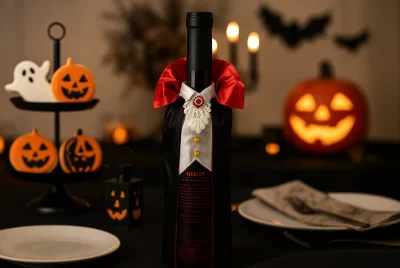Wine Travel Destinations: Top Vineyards Worldwide
Post Disclaimer
*We may earn a commission for purchases made using our links. Please see our disclosure to learn more.
There’s something magical about sipping a glass of wine while gazing across the vineyards where its grapes were grown. As someone who has spent years traversing the world’s wine regions, I’ve discovered that wine tourism offers so much more than just tastings, it’s about connecting with centuries of tradition, meeting passionate winemakers, and immersing yourself in landscapes that seem painted specifically for postcard perfection.
Wine travel combines my two greatest passions: discovering exceptional wines and exploring new destinations. Whether you’re a seasoned oenophile or simply enjoy the occasional glass, visiting wine regions provides a sensory adventure that engages all five senses and creates memories that linger long after the last sip.
Key Takeaways:
- The best wine destinations offer diverse experiences beyond just tastings, including cultural immersion, gastronomy, and stunning landscapes
- European classics like Tuscany and Bordeaux offer historical depth, while New World regions like Napa and Mendoza bring innovation and spectacular scenery
- Off-the-beaten-path destinations such as Georgia and Portugal’s Douro Valley provide authentic experiences away from tourist crowds
- Wine travel is highly seasonal; timing your visit around harvest (typically late summer to fall) offers the richest experience
- Guided tours can provide expert access, but independent exploration allows for more intimate discoveries and unexpected finds
Classic European Wine Destinations
Tuscany, Italy
The first time I drove through Tuscany’s rolling hills, I understood why this region has captivated travelers for centuries. Medieval hilltop towns emerge from morning mists, cypress-lined roads wind through perfect vineyards, and everywhere you turn, there’s an opportunity to sample world-class Chianti Classico, Brunello di Montalcino, or Super Tuscans.
I recommend basing yourself in Siena or one of the smaller towns like Montepulciano, where you can spend mornings exploring Renaissance art and architecture and afternoons visiting family-run wineries. At Castello Banfi near Montalcino, I enjoyed not just exceptional Brunello but also a farm-to-table lunch featuring wild boar pappardelle that perfectly complemented their robust reds. What makes Tuscany so special is how seamlessly wine integrates with the region’s other treasures, art, history, and cuisine come together in perfect harmony.
Bordeaux, France
Bordeaux represents wine tradition at its most refined. The grand châteaux of the Médoc, with their manicured grounds and centuries of winemaking history, offer a glimpse into the aristocratic roots of fine wine production. On my first visit to Château Margaux, I was struck by the reverence with which the guide spoke about their terroir, that magical combination of soil, climate, and human touch that creates their legendary wines.
The city of Bordeaux itself has transformed in recent years, shedding its once-sleepy reputation to become a vibrant cultural hub. I spent hours at La Cité du Vin, an interactive wine museum where cutting-edge technology helps visitors understand wine’s cultural significance throughout human history. After dark, the wine bars along the Garonne River serve everything from prestigious classified growths to surprising discoveries from smaller producers.
Champagne, France
Just a 45-minute train ride from Paris, the Champagne region feels worlds away from urban life. Here, beneath rolling hills covered with precisely maintained vineyards, lies a network of ancient chalk cellars where millions of bottles slowly mature into the world’s most celebrated sparkling wine.
My tour of Moët & Chandon’s 28 kilometers of underground cellars in Epernay revealed the painstaking traditional methods still used to create their prestigious champagnes. But equally memorable was my visit to a small grower-producer in the village of Aÿ, where the winemaker himself poured his champagnes while explaining how his family had cultivated the same plots for seven generations. The contrast between these experiences, the global luxury brand and the artisanal producer, perfectly encapsulates Champagne’s dual identity.
New World Wine Adventures
Napa Valley, California
Napa represents the American dream translated into winemaking. In just a few decades, visionary vintners transformed this valley into one of the world’s premier wine destinations. During my week-long exploration, I was struck by Napa’s diversity, from the castle-like Castello di Amorosa with its medieval-inspired tasting rooms to the sleek modernism of Opus One’s iconic building.
What truly sets Napa apart is its commitment to visitor experiences. Unlike some traditional European regions, Napa embraces wine tourism wholeheartedly. I joined a blending session at Raymond Vineyards where I created my own Bordeaux-style blend, complete with a custom label to take home. Later, at Hess Collection, I wandered through their world-class contemporary art museum between tastings of their mountain-grown Cabernet Sauvignon.
Mendoza, Argentina
Against the dramatic backdrop of the snow-capped Andes, Mendoza’s vineyards stretch across an arid plain transformed by irrigation into a winemaking paradise. This stunning juxtaposition, desert meets viticulture meets mountain grandeur, creates a wine landscape unlike any other I’ve experienced.
At Catena Zapata, whose pyramid-shaped winery pays homage to ancient Mayan architecture, I tasted Malbecs that revealed the grape’s full potential, something rarely achieved in its French homeland. Between tastings, I ventured into the mountains for a gourmet picnic lunch prepared by a local chef, accompanied by bottles from boutique producers available only within Argentina. The combination of exceptional wines, breathtaking scenery, and warm Argentine hospitality makes Mendoza a must-visit for any wine lover.
Marlborough, New Zealand
The crystalline purity of Marlborough Sauvignon Blanc mirrors the pristine landscapes where it’s grown. On New Zealand’s South Island, I found vineyards nestled between mountains and sea, creating a distinctive microclimate that produces those instantly recognizable vibrant, aromatic whites.
Exploring the region by bicycle allowed me to appreciate both the wines and the spectacular scenery at a leisurely pace. At Cloudy Bay, whose wines first brought international attention to New Zealand’s wine industry, I enjoyed a flight of single-vineyard Sauvignon Blancs that demonstrated the variety’s remarkable expressiveness in different sites. Later, a seafood feast at a small waterfront restaurant in the Marlborough Sounds, paired with local wines, perfectly captured the region’s maritime influence both on plate and in glass.
Off-the-Beaten-Path Wine Destinations
Douro Valley, Portugal
Perhaps my most magical wine experience was sailing along Portugal’s Douro River on a traditional rabelo boat, surrounded by steep terraced vineyards that have produced port wine for centuries. UNESCO-protected, these dramatic landscapes represent some of the most challenging and beautiful wine country in the world.
I stayed at a quinta (wine estate) that offered both traditional port wines and the increasingly acclaimed dry reds and whites now emerging from the region. My host, a fifth-generation winemaker, invited me to join the grape harvest, where I spent a morning picking alongside local workers before a celebratory lunch featuring bacalhau (salt cod) and generous pours of estate wines. The Douro offers that increasingly rare combination of world-class wines, breathtaking scenery, and authentic experiences uncorrupted by mass tourism.
Georgia (The Country)
Wine history doesn’t get deeper than Georgia, where archaeological evidence of winemaking dates back 8,000 years. In this ancient land at the crossroads of Europe and Asia, traditional methods persist alongside modern innovations, creating a wine culture unlike any other I’ve encountered.
I visited a family winery in the Kakheti region, where wine is still fermented and aged in qvevri, large clay vessels buried underground. These natural wines, made with minimal intervention and indigenous grapes like Saperavi and Rkatsiteli, offered fascinating flavors that challenged my Western-trained palate. Between tastings, I joined a supra (traditional feast) where wine flowed freely alongside Georgian specialties like khachapuri (cheese bread) and khinkali (dumplings), all accompanied by polyphonic singing and heartfelt toasts from my hosts.
Valle de Guadalupe, Mexico
Just 90 minutes south of the US border lies Mexico’s answer to Napa Valley, a region producing wines of surprising quality and character. The Valle de Guadalupe combines Mediterranean-like growing conditions with Mexican hospitality and culinary traditions, creating a distinctive wine destination that remains off most travelers’ radar.
I spent three days exploring small family wineries and innovative architectural marvels like Decantos Vinícola, whose gravity-flow design eliminates pumps to enhance wine quality. Between tastings, I enjoyed the region’s unique “Baja Med” cuisine, which fuses Mexican ingredients with Mediterranean and Asian influences. At Corazón de Tierra restaurant, surrounded by the garden where most ingredients are harvested, I savored a tasting menu paired exclusively with Valle wines, proving that Mexican viticulture has truly come of age.
Planning Your Wine Travel Adventure
The best wine trips combine advance planning with room for spontaneity. I’ve found that visiting three to four wineries per day allows for unhurried tastings and meaningful conversations with winemakers. Whenever possible, I schedule visits around mealtimes, there’s no better way to understand a region’s wines than enjoying them with local cuisine.
Timing matters tremendously. While vineyards are beautiful year-round, harvest season (typically late August through October in the Northern Hemisphere) offers the most dynamic experience, with the excitement of grape picking and crushing. Alternatively, spring brings budding vines and fewer crowds, while winter offers cozy cellar tours and more personal attention from winemakers during their quiet season.
Consider hiring local guides for at least part of your journey. On many occasions, my guides’ personal connections opened doors to private tastings and meetings with winemakers not typically available to the public. That said, I also value setting aside time for independent exploration, some of my most memorable wine discoveries have come from following a promising road sign or accepting a local’s recommendation.
Conclusion
Wine travel offers a perfect blend of sensory pleasure, cultural immersion, and natural beauty. Whether you’re exploring the historic cellars of Champagne, the sun-drenched vineyards of Mendoza, or the ancient traditions of Georgian winemaking, these journeys connect us to place in profound ways. Each bottle tells a story, of soil and climate, tradition and innovation, and the passionate individuals who transform fruit into art.
As I reflect on years of wine adventures across six continents, I’m struck by how these experiences have enriched my understanding not just of wine but of history, agriculture, and cultural identity. Wine regions reveal themselves slowly, rewarding those who linger and engage deeply with their surroundings. The finest wine travel memories often come not from tasting rare vintages but from meaningful human connections, a winemaker sharing family stories over a simple lunch, or a fellow traveler becoming a friend over an unexpected bottle discovery.
Whether you’re planning your first wine region visit or your fifteenth, approach each destination with curiosity and openness. The world of wine travel offers endless variations on a beautiful theme, the celebration of place through its most expressive agricultural product.
Frequently Asked Questions
What’s the best time of year to visit wine regions?
For the Northern Hemisphere (Europe, North America), September and October offer the excitement of harvest season plus generally pleasant weather. Southern Hemisphere regions (Argentina, Australia, New Zealand) have their harvest from February through April. That said, each season offers unique advantages—spring brings beautiful flowering vines, summer offers long days and outdoor events, and winter provides more intimate experiences with winemakers who have more time to spend with visitors.
Do I need to be a wine expert to enjoy wine tourism?
Absolutely not! Most wineries welcome visitors of all knowledge levels. The best approach is to be open about your experience, whether you’re a novice or advanced, so tastings can be tailored appropriately. Many regions offer introductory wine courses for visitors; taking one early in your trip can enhance your subsequent tasting experiences.
How many wineries should I plan to visit per day?
Three to four is generally ideal, allowing enough time for meaningful tastings without palate fatigue. I recommend scheduling your most important visits in the morning when your senses are sharpest. Always include time for lunch, preferably at a winery restaurant where food and wine pairings enhance your understanding of local gastronomy.
What’s the proper tasting room etiquette?
Across most wine regions, it’s acceptable to spit rather than swallow tastings (especially if driving). Don’t wear perfume or cologne, which interferes with wine aromas. If there’s a tasting fee, it’s often waived with purchase, but don’t feel obligated to buy. Lastly, it’s wise to make appointments, particularly for smaller wineries—even if their literature says “walk-ins welcome,” calling ahead ensures a better experience.
How do I transport wine purchases home?
For international trips, specialized wine luggage with protective inserts works well for bringing back a few special bottles. For larger quantities, many wineries offer shipping services, though international wine shipping can be complex due to varying regulations. Within the same country, wine shipping is generally straightforward. Always check current airline and customs regulations before traveling, as rules regarding alcohol transport frequently change.




